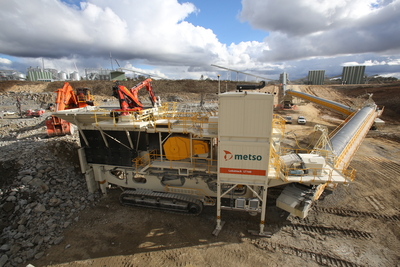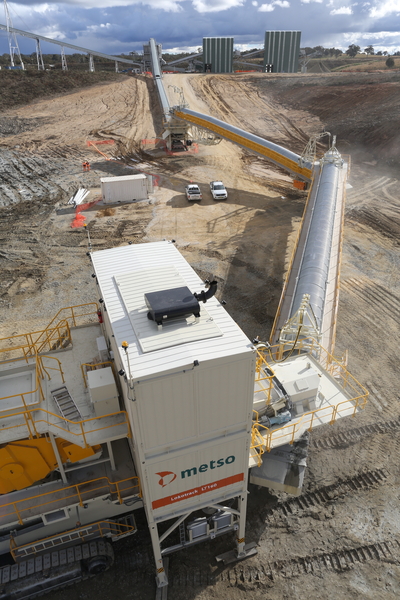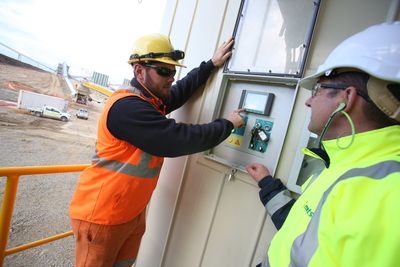Boral's Peppertree quarry achieves an industry-leading mobile crushing solution
Tuesday, 12 November, 2013
Due to the anticipated depletion of raw material reserves at the one hundred-year-old Penrith Lakes Scheme in Sydney, of which Boral is a major shareholder, it has been necessary to find a new source of materials to address the needs of Sydney’s construction industry into the future.
As part of Boral’s Sydney Aggregates Project, Boral has implemented an innovative in-pit crushing solution at its new Peppertree quarry, situated at Marulan South in the NSW Southern Tablelands, around 180 km south-west of Sydney. Due to become fully operational in 2014, the new quarry will supply the Sydney metropolitan area and greater NSW building and construction industries with up to 3.5 million tonnes of aggregate products per annum.
“We have over 80 million tonnes of proved resource at Peppertree and over 1.8 billion tonnes of inferred resource on land owned by Boral in the Peppertree area. This puts us in a great position for sustainable long-term supply of high-quality construction materials into Sydney and the surrounding areas,” explained Sydney Aggregates Project executive manager David Bolton.
In addition to the Peppertree quarry, the $200 million Sydney Aggregates Project includes new rail infrastructure in and around the quarry, a new manufactured sand plant at Boral Cement in South Marulan and a new rail transfer terminal at the Boral Maldon Cement Works near Picton, NSW.
Mobile in-pit crushing
After more than a decade of planning, construction of the new facilities at Peppertree started in July 2011. Risk assessment of the crushing process led to the selection of in-pit crushing as the safest and most efficient option for the new plant.
“Boral is now looking to optimise its quarrying process and get away from the traditional load and haul methodology where you have a large number of trucks and people moving between the blast site and the fixed crushing plant,” said Boral Site Manager Steve Parsons.
The mobile crushing solution implemented at Peppertree has allowed Boral to significantly reduce its mobile fleet with its associated fuel consumption, safety risks and maintenance requirements.

Sydney Aggregates Project senior OHS adviser Natalie Constantine said the mobile crushing solution suits Boral on a number of fronts. “One is the safety aspect - it reduces our mobile fleet so we’ve got less traffic movements on the site, which is much safer,” she explained. “From an environmental perspective, it reduces fuel consumption and the environmental impact of dust emissions. From a health and safety as well as an environmental perspective, it’s a really great solution - but most importantly, from an operational perspective it does everything we need it to do.”
Rigorous research into finding a crusher that could handle the planned production volume at the Peppertree plant led Boral to select Metso’s Lokotrack LT160 together with the company’s patented Lokolink mobile conveyor system.
Intensive design consultation process
The Lokotrack LT160 at Peppertree is the largest mobile crusher in the Southern Hemisphere, weighing in at 285 tonnes and measuring 12 m high by 25 m in length. Extensive design consultation between Boral’s technical staff and Metso’s design team prior to design finalisation and manufacture has produced the most sophisticated machine of its kind, with a number of innovations not seen on a mobile machine before.
From the outset, Boral was determined to ensure its new facilities incorporated world’s best standards in safety, sustainability and efficiency. One of the major challenges was to customise the LT160 to meet Boral’s strict safety requirements, which are even more stringent than either Australian or European standards. To achieve this, Boral put together a team of designers, engineers, operators and OHS personnel to review the LT160 design and to identify any potential hazards and improvements before accepting the final design.
This was a new approach for Boral. “We generally buy off-the-shelf plant and subsequently modify it on-site,” explained Boral Project Manager Kai Kane. “We spent a number of days with Metso’s designers in the UK then another two or three days with the designers in Finland to get the process underway. Subsequent to that, there were a number of videoconferences that delivered the machine that we have today.”
Regular videoconferencing between the Boral and Metso teams was carried out over a six-month period and allowed various improvements to be made, with about 50 safety-related and general design changes compared to the machine’s previous design. 3D models were used to conduct a virtual ‘walk through’ of the plant. Risk assessments were carried out at each design stage. As part of the selection and design process, the Boral team also reviewed an LT160 that has been operating at Swindon in the UK for around 10 years.
As well as ensuring that the crusher conformed to Boral’s stringent safety requirements and was easy to operate and maintain, minimising noise was also an important outcome. “At Peppertree we have to meet certain noise criteria,” said Boral Environmental Adviser Sharon Makin. “We modelled the noise impact using real-time data from a similar operating crusher to make sure that the new machine and its controls would work for us.”
Unique features
The LT160 at Peppertree has a number of features which make the machine unique with regard to current safety practices. Some of the solutions, such as guarding and using stairs rather than ladders for maintenance access, are Australian standards requirements whereas others are unique requirements that arose during the design consultation phase including:
- Shrouds around the crusher to reduce both dust and noise.
- Rubber wear liners on the hopper to reduce noise.
- A service crane installed for jaw liner changes to eliminate the need for a mobile crane.
- Walkways that extend the full length of the Lokolink conveyors on both sides (rather than one side).
Some of the solutions are extremely simple but very effective. For example, the exterior lights on the crusher have magnetic mounts so operators can move them around to ensure the best lighting of their work areas at night.

“Another thing that’s really interesting is the segregation of the electrical switch room,” said Natalie Constantine. “It appears to be all one structure but, when you put the crusher in situ, the electrical switch room has its own legs that jack up to slightly separate it from the rest of the structure so it isn’t affected by vibration when the equipment is operating. That’s a very neat solution and will reduce maintenance resulting from wear and tear on that part of the building. It’s another one of those really clever solutions that Metso put in place.”
Ensuring that the machine fully met Australian standards as well as Boral’s requirements before delivery brought the company significant cost savings by avoiding the need for site rework and retrofits along with associated loss of production.
Truckless mining
In a conventional crushing plant, a drill and blast team blast the shot and develop a muck pile. A front-end loader at the muck pile loads haul trucks which transport the rock to a fixed primary crusher. With the in-pit crushing solution at Peppertree, an excavator located on the muck pile loads material directly into the Lokotrack’s hopper. The rock moves along a grizzly feeder that passes undersized rock directly onto the machine’s outbound conveyor. Only the large rock that needs to be crushed passes through the jaw crusher, which is capable of processing rocks up to one metre in size. In this way, energy isn’t wasted on passing small material through the crusher.

Crushed rock is then transported to the fixed, in-pit belt conveyor via two mobile Lokolink conveyors. The fixed conveyor carries crushed rock from the Lokotrack to the fixed plant for further processing. A patented swivel mechanism on the Lokolink conveyors ensures crushed material flows freely at all conveyor angles.
The Lokotrack LT160 can crush 1150 tonnes of rock per hour and needs to be relocated every few hours - a process which can be done in minutes by an operator via a remote console worn around the operator’s waist. The Lokotrack is moved to the next loading position and the unique technology of the Lokolink conveyors allows them to simply follow.
When blasting is performed, the Lokotrack and Lokolink conveyors move to a safe distance around 70 m away. After the blast, a wheel loader cleans the quarry floor and the Lokotrack moves to the new muck pile. Operation resumes with minimal production downtime.
When the time comes to move to a different pit location, the Lokolink conveyors are disconnected from the field hopper using hydraulic actuators. The Lokotrack and Lokolink conveyors can also move from one level to another along a normal ramp.
The LT160 is a fully self-contained electrical machine. The track-mounted drive of the machine is hydraulic while the grizzly feeder and the 200 kW crusher motor are driven electrically so there is no environmental impact from diesel fumes. However, in case electrical power is unavailable, the machine has a reliable, onboard CAT diesel generator which can be used to run the Lokotrack’s hydraulic system and Lokolink conveyors.
Automation and control of the crusher and conveyor
The Lokotrack’s start-up and crushing process is automated by a Metso IC900 PLC-based system designed to protect, control and operate the machine. Hydraulic oil pressure and temperature sensors as well as conveyor and feeder speed sensors are located around the machine and wired to decentralised I/O modules that are connected back to the IC900 system via CANbus. Critical machine parameters provided by the sensors can be monitored at the user interface, which is also connected to the control system via CANbus. If any of the process parameters, such as pressure or temperature, move beyond their range limit, a warning or alarm is given at the display.

The IC900 is connected via the Metso Gateway to Boral’s DCS and SCADA system so that all operation can be monitored remotely. The Modbus-based gateway interface on the LT160 is connected wirelessly to an ethernet port on the field hopper and then cabled to the site’s control room.
Feed rate control to the crusher is a crucial parameter for process optimisation. Operating in automatic mode, the IC900 system can make adjustments to the feed rate or, if necessary, stop the feed altogether. As well as showing on the IC900’s display, process parameters are sent wirelessly to a human-machine interface (HMI) panel located in the operator’s cabin of the Hitachi EX1200 excavator. Cameras on the LT160 show the excavator’s operator what is happening within the feed process on the Lokotrack. If necessary, the operator can take over to finetune the feed rate via the HMI panel in his cabin.
A belt weigher incorporated in the first Lokolink continuously monitors product output, which is displayed by the IC900 display on the LT160. A separate, specific belt weigher display is located in the excavator next to the HMI panel.
The automation system controls the entire crusher start-up process. The operator only has to start the LT160 then press the process start-up button and the IC900 sequentially starts the entire system beginning upstream with the field hopper pan feeder, the Lokolink conveyors, additional devices (water spray system), the Lokotrack’s main conveyor, the crusher, the grizzly feeder and then the LT160 pan feeder.
Effective communication leads to a perfect project
After the machine was delivered to the Peppertree site in late 2012, the LT160 went through a three-stage commissioning process (static, dry and wet) and achieved practical completion in the middle of August this year.
According to David Bolton, “We believe that the outcome of the design process will result in overall lower costs of operation.
“One of the key learnings for Boral from this project is that when importing plant and equipment there are a number of opportunities to adjust the design and capability of the equipment. These opportunities are rarely taken up by Australian industry. We’ve found that the need to partner with offshore suppliers is critical - and it’s achievable.”
While there were challenges with adapting the LT160 to Boral’s rigorous standards, Steve Parsons said the project ran extremely well due to Metso’s commitment as well as the trust and rapport between the Metso and Boral teams. “The whole thing worked very well. It was the understanding of what was required and the ability of both teams to communicate seamlessly that delivered the result. It’s the perfect template for a project.”
Robotic storage system transforms NZ pharmaceuticals warehouse
New Zealand's first AutoStore has significantly improved intralogistics operations for...
Egg producer improves efficiency with flexible marking system
A Spanish poultry company needed an operator-friendly and reliable marking system to mark 200,000...
Women in automation: Ella Shakeri
On International Women's Day 2024, Swisslog System Design Engineer Ella Shakeri is...












